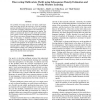Free Online Productivity Tools
i2Speak
i2Symbol
i2OCR
iTex2Img
iWeb2Print
iWeb2Shot
i2Type
iPdf2Split
iPdf2Merge
i2Bopomofo
i2Arabic
i2Style
i2Image
i2PDF
iLatex2Rtf
Sci2ools
AAAI
2007
2007
Discovering Multivariate Motifs using Subsequence Density Estimation and Greedy Mixture Learning
The problem of locating motifs in real-valued, multivariate time series data involves the discovery of sets of recurring patterns embedded in the time series. Each set is composed of several non-overlapping subsequences and constitutes a motif because all of the included subsequences are similar. The ability to automatically discover such motifs allows intelligent systems to form endogenously meaningful representations of their environment through unsupervised sensor analysis. In this paper, we formulate a unifying view of motif discovery as a problem of locating regions of high density in the space of all time series subsequences. Our approach is efficient (sub-quadratic in the length of the data), requires fewer user-specified parameters than previous methods, and naturally allows variable length motif occurrences and nonlinear temporal warping. We evaluate the performance of our approach using four data sets from different domains including on-body inertial sensors and speech.
| Added | 02 Oct 2010 |
| Updated | 02 Oct 2010 |
| Type | Conference |
| Year | 2007 |
| Where | AAAI |
| Authors | David Minnen, Charles Lee Isbell Jr., Irfan A. Essa, Thad Starner |
Comments (0)

